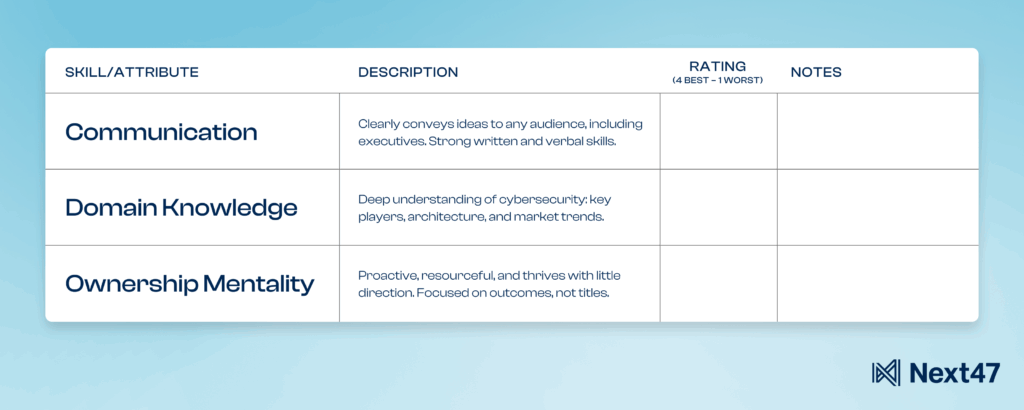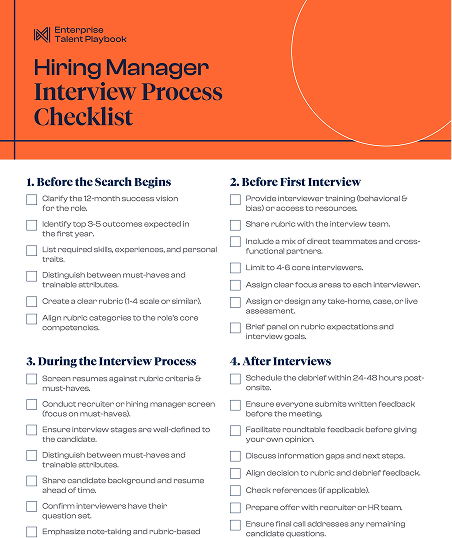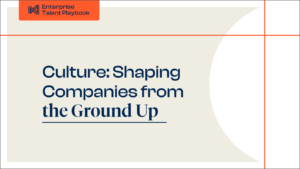Why does running an effective interview process matter? Why not just wing it? After all, your interviewers are experienced and they’ll ask the right questions, right?
Wrong.
A strong interview process isn’t just a box to check. It’s your opportunity to:
- Define what success looks like in the role
- Build alignment through preparation, debriefs, and consistency
- Showcase your company culture and professionalism
- Reduce bias and make a well-informed hiring decision
An effective process signals to candidates that you’re serious, thoughtful, and invested, not just in hiring them but in building the best team possible. And remember: your employer brand is always on display, especially in early-stage hiring. A disorganized or poor process can be a big turnoff for top talent and even cause them to dissuade their network from interviewing with you.
This article will walk you through the steps of setting up and running a robust interview process.
Begin with the End in Mind
Envision your new hire one year from now. What will they have accomplished? What will success look like? Once you have that figured out, you can start identifying what you need in a candidate. Try asking yourself questions like:
- What skills, traits, and experiences are required to reach those outcomes?
- Which are must-haves, and which can be trained?
From there, build a rubric or scorecard that outlines your criteria.

Build the Right Interview Panel
Your interview loop should include a diverse mix of colleagues who will work directly with the new hire and represent cross-functional teams.
Keep the panel small but effective, around 5 people is ideal. This enables collaboration without creating decision paralysis. If you want to include others (e.g., for culture fit), consider informal touchpoints like a lunch or coffee during the onsite.
Suggested Loop Structure

If you lack expertise for a specific role, as is common in a startup, consider bringing someone external into the loop. This could include someone at your investor’s firm or a trusted colleague.
Prepare Before the First Interview
Even experienced interviewers need a refresh. If you do not have a training team, there are free training courses on LinkedIn, including Behavioral Interviewing and Effective Listening. Once you have built a rubric and interview loop, put it to work before kicking off the process:
- Assign each panelist specific focus areas from the rubric
- Encourage the development of 2–3 targeted questions per area
This approach ensures you gather consistent, relevant feedback while making the best use of everyone’s time. We’re all busy, but preparing before each interview helps us collect meaningful data points and avoid subjective decision-making.
The Power of the Debrief
The debrief is the moment where everything aligns. It’s your opportunity to bring together feedback, surface any red flags or gaps, and ask clarifying questions that may not have been captured in interview notes. A well-run debrief helps resolve discrepancies, ensures interviewers stay focused on their assigned areas, and allows for valuable coaching and calibration. Most importantly, it enables you to move quickly and confidently toward a hiring decision.
Best Practices:
- Schedule the debrief immediately after the final interview
- Share notes beforehand so participants come prepared
- Have everyone share independent opinions first before the HM weighs in (to reduce groupthink)
- Identify if any voices carry more decision weight, and be transparent about that
Use this moment to remind the team that decisions should be tied to rubric criteria, not just gut feel.
Bonus: Culture & Candidate Alignment
Hiring isn’t just about skill—it’s about fit. Ask yourself:
- Will this candidate thrive in your company’s stage and pace?
- Are they adaptable, hands-on, and aligned with your mission?
The final conversation is a two-way street. Give the candidate space to ask questions and assess their understanding of the role and company. Ask: “Do they have everything they need to say yes?”
Use the process itself to reflect your culture. For example:
- Do you have an in-office culture? Then bring them on-site.
- Are you feedback-driven? Offer constructive input during interviews.
- Is your company a high-bar environment? Be rigorous but fair.
These moments give candidates insight into the real experience of working with you.
Conclusion
A great hire starts with a great process, and that process is fully within your control. By clearly defining success, preparing your team, and running a thoughtful, structured interview loop, you set the foundation for strong, confident decisions. When you showcase your culture, treat candidates with respect, and rely on data rather than instinct alone, you not only find the right person for the role, but you strengthen your team and your company’s future. Invest the time, trust the process, and watch the results follow.

Download our Hiring Manager Checklist
Fill out this form to get started on your hiring process.


